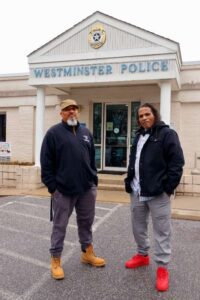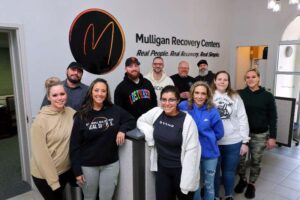by Katie V. Jones, photography by Nikola Tzenov
When drugs are plentiful, helping addicts break the habit
It can be easy, with our rolling hills and safe neighborhoods, to think that we are protected from issues faced by more urban areas. If you haven’t been directly impacted by substance use disorders, then you might even think we don’t have a drug problem here in Carroll County. But our somewhat rural little community is battling in a fierce fight against a vicious foe. The face has changed over the years — heroin, meth, crack, fentanyl — but these drugs, and the addiction that comes with them, take lives, and stresses our local healthcare systems and first responders. The drug crisis impacts everyone in Carroll County.
Addiction is a terrible disease, and local experts say the drug scene is thriving in Carroll County. Law enforcement agencies and the Carroll County Health Department continue to learn, understand and find ways to overcome our county’s drug-related problems.
Fentanyl: Prevalent and Deadly
Fentanyl — a synthetic opioid that is up to 50 times stronger than heroin and 100 times stronger than morphine — and crack cocaine are currently the most frequently seen drugs in Carroll County according to Brant Webb, drug intelligence/heroin coordinator, Washington/Baltimore HIDTA, Carroll County Drug and Firearms trafficking unit. Of the two, fentanyl is the most deadly threat.
“Fentanyl has pretty much eliminated heroin in the area,” Webb said in an email.

In 2022, there were 54 overdose deaths in Carroll County. One was due to heroin and 34 of those were due to fentanyl, Webb said. This past January, there were 36 overdoses in Carroll County and three of them were fatal, according to the Carroll County Sheriff’s Office Overdose Investigative Summary report of Feb. 1. Fentanyl was responsible for 10 of those overdoses.
“Fentanyl is the hot button. We see a lot of it,” said Carroll County Sheriff’s Office Chief Deputy Colonel Richard Hart.
In Carroll, fentanyl is typically contained in clear gel capsules, Webb said, though it can be found in a variety of colors. It is often mixed with other drugs, unbeknownst to buyers, who are not aware of the drug’s strength.
“It is popping up in everything,” said Brian McCall, program director at Mulligan Recovery Centers in Westminster. “People think they are getting real heroin and it’s really fentanyl. Fentanyl is the biggest killer of our community.”
Because “fentanyl gives a shorter high than pure heroin, and users suffer from withdrawal symptoms much quicker without using again,” dealers are adding xylazine, a non-opioid veterinary tranquilizer, to “improve euphoria and lengthen the high,” Webb wrote.
“People want the best high and are taking their chances,” Hart said.
While there hasn’t been a significant increase in fatalities in Carroll due to xylazine, its popularity is increasing, Webb said, as it is becoming more difficult to obtain heroin not mixed with fentanyl. Xylazine can cause soft tissue damage, including holes, abscesses and gangrene, Webb said, and if the vein is missed while injecting, it can cause the arm to turn black.
Xylazine is not a controlled substance and can be purchased legally online.
Most users in Carroll go to dealers in Baltimore City to get their drugs, where they pay about $6 to $8 for fentanyl caps and then sell them in Carroll for $10 to $20, Webb said.
“We arrest some dealers here, but those folks go to Baltimore to get what they need, too,” Hart said. “People will pull over to use drugs and don’t make it home. They’re in a vehicle accident, passed out with a needle still in their arm. That addiction is that bad.”
Anyone, no matter their age or occupation, can be a victim of illicit drugs, Hart said. According to the Carroll County Sheriff’s Office Overdose Investigative Summary January 2023 report, 11 overdoses were people between the ages of 25 to 34; eight overdoses were people between 45 and 54; and there were six overdoses for people ages zero to 18.
“It affects every factor of life. You see it with everybody,” Hart said. “It’s across the board.”
LEAD initiative
The underlying cause for many of the county’s minor crimes and minor thefts, Hart said, is drug-related, as addicts need money for their expensive habits. In an effort to help those individuals instead of putting them in jail, the county sheriff’s department is working toward adopting the Law Enforcement Arrest Diversion (LEAD) initiative program.

Created in Seattle in 2011, LEAD gives law enforcement officers the ability to refer individuals who committed low-level crimes to public health services instead of making an arrest. According to the Carroll County Health Department, individuals 18 years and older who are arrested for either drug offenses, prostitution, misdemeanor theft, low-level burglary, rogue and vagabond, and nuisance crimes can be referred to the program.
LEAD is not, according to the website, “a get out of jail free card.” Rather, it is a commitment to long-term care with individuals working with case managers to create a plan specifically for them.
Looking for an innovative way to address the overdoses happening within city limits, Westminster Police Chief Tom Ledwell adopted LEAD in August 2020.
“Westminster city has a robust program,” Hart said. “They have a lot of drug issues within Westminster. Tom Ledwell, Westminster police chief, does a remarkable job.”
Most people who begin LEAD are hostile and angry, said Toma Smith, a Peer Recovery Specialist for the LEAD Program with the county Health Department who works with the Westminster Police. Smith can relate to that because of his own history of addiction.
“I’m a peer who is in long-term recovery,” Smith said. “People are scared of police. We’re not police, but we work alongside the police. We’re like cousins.”
LEAD helps those in the program get the services they need, Smith said, and encourages them to remain in recovery.

“My job is to try to help them find the power they already have,” Smith said.
Another benefit of the program, according to the LEAD National Support Bureau website, is the rebuilding of positive relationships between individuals and police officers. The sheriff’s department hopes to get its LEAD program running within six months, Hart said.
“We are working closely with the Health Department,” Hart said. “We do everything we can to help. It is another tool in our toolbox. Another resource.”
Start-up funding for LEAD began in fall 2019 and Carroll County, as a sub-grantee recipient, received additional grant funds through the Comprehensive Opioid, Stimulant and Substance Abuse Program grant that was awarded to the Governor’s Office in the spring of 2020.

to be proactive.”
–RON BRODIE,
PEER RECOVERY SPECIALIST,
LEAD (LAW ENFORCEMENT
ARREST DIVERSION)
“This allowed our program to continue for three additional years,” said Veronica Dietz, director of crisis services for the Carroll County Health Department, in an email. “Our office is seeking additional funding to continue this initiative for our community.”
Another important tool is naloxone, or Narcan, a nasal spray that when administered after someone has overdosed on opioids can prevent death.
Though it is not an opioid, xylazine overdoses are also treated with naloxone because xylazine is typically combined with opioids. There is a concern, however, that the growing presence of xylazine in opioid overdoses will cause naloxone to be less effective.
The Westminster police have naloxone kits available for the public and the Health Department offers training sessions in their use.
“It has saved a lot of lives,” Hart said.
Quick Response Team and recovery
During overdose calls in Westminster, Westminster police are now accompanied by the Quick Response Team (QRT). Created in May 2022, the QRT is a partnership between the Health Department and the Westminster police. The team consists of a case manager and peer support specialist who accompany the police to the scene of an overdose. If the victim survives, the QRT takes over.
“If they accept help, we help them with whatever they need,” said Ron Brodie, a peer support specialist. “It’s about reaching the people. We try to be proactive.”
QRT uses a harm-reduction approach with individuals to discuss treatment options and educate them on the benefits of having medically recommended care, according to the Health Department’s QRT pamphlet. QRT can also assist with housing referrals, obtaining identification and assisting with clothing and food resources.

–TOMA SMITH,
PEER RECOVERY SPECIALIST,
LEAD (LAW ENFORCEMENT
ARREST DIVERSION)
“It is not a good thing to be called out to an overdose,” said Brodie, though he acknowledges “they got a fair number.”
Brodie, himself, has overdosed more times than he can count, he said. A 12-step program and fellowship helped him, and the Carroll County resident soon got into peer work, first sharing his story at Greater Baltimore Medical Center in Towson and then at Carroll Community Hospital, before becoming part of QRT.
“We’ve been there,” Brodie said, of himself and fellow peer specialists. “We develop a relationship with that person and follow up with them.”
All employees at Mulligan Recovery Centers are in recovery, McCall said, himself included.
“I have been clean since 2007,” said McCall, who moved to Carroll County 14 years ago with his wife, who is also in recovery, because of the “great recovery community in Westminster.”
“It is so supportive,” McCall said. “It is very strong, open and accepting.”
Mulligan Recovery Centers opened in 2019. At first, it was just a sober home for men, a place they could stay if they remained clean, held a job and followed a few rules.
“We saw a need to offer more services,” said McCall, noting that Mulligan is now open to both men and women 18 years or older, and offers both long-term residential care and outpatient programs. The program’s approach, McCall said, is to offer compassion, love, understanding and empathy, or CLUE.
“Most times, people who struggle with addiction have some type of trauma,” McCall said. “If you feel safe, the mental walls come down and you are able to treat them.”
About 70 percent to 80 percent of Mulligan’s clients are local to Carroll County, McCall said.
“We don’t tend to have a lot of people return,” McCall said. “We do our due diligence and make sure the person is getting the care and treatment needed. It is not a cookie cutter thing.”
Education, Hart said, is key to combating drugs. The Health Department works with numerous partners throughout the county, including Carroll County Public Schools, Boys & Girls Club of Carroll County and the Carroll County State’s Attorney’s Office, to educate the public about the use and misuse of drugs. The Carroll County Opioid Prevention Coalition, a group of 100 community members, meets every other month to review data and develop strategies for prevention, education, referrals and support.
The Health Department also coordinates a Local Overdose Fatality Review Team to identify missed opportunities for prevention and interventions; increase interagency communication and collaboration; and make recommendations for new laws.
“When it comes to addiction, it’s not about the substance, it’s about the person,” McCall said. “You find out what pains them to use in the first place. Most addicts will use anything to not feel the way they’re feeling.”













